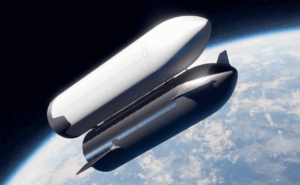With the exploration of our solar system beginning anew, advances in spacecraft technology may shape how our civilization moves forward.
Fifty years ago, the first humans set foot on the moon. Now, decades later, it seems they will be going back. With the advent of NASA’s Artemis mission, the plan to bring humans to the moon by 2024 has been set in motion (1). As humanity thinks about expanding even farther into the solar system, what technologies will be needed to make it possible? It begins with a rocket motor. The basics of all rocket motors are the same, where a substance with mass is ejected out of the motor, propelling the rocket in the other direction (2).
There are three things that must be considered for any rocket motor’s operation. Delta-V (m/s) is the total change in velocity a rocket motor can achieve with its fuel and affects the spacecraft’s range (3). Specific impulse (seconds of Isp) is the efficiency of the rocket motor, i.e. how much thrust it can produce by using each unit of fuel (4). This affects the amount of fuel required on your spacecraft (4). Thrust (newtons) is the actual force with which the rocket motor propels the spacecraft and affects the spacecraft’s acceleration (5).
The reason these aspects of rockets are important is that different types of rockets with varying degrees of these three attributes will be required in order to achieve success in space exploration. High-thrust rocket motor systems will be needed to escape Earth’s gravity and atmosphere, while rocket motors with high specific impulse and delta-V will be needed for long-distance space travel.
An example of a chemical rocket: the three nozzles on NASA’s Delta IV-Heavy burn hydrogen and oxygen to produce large amounts of thrust (8).
Chemical rockets are the most widely used form of propulsion. They operate by mixing and then burning a fuel and oxidizer, and they feature incredibly high thrust (6). Their drawback is an extremely low specific impulse, about 450 seconds at best, and low Delta-V (7). A chemical rocket is like a sports car which can accelerate from 0 to 60 in only 4 seconds, but can drive for just 50 miles. Chemical rockets are needed for fighting against the gravity of Earth and the resistance of its atmosphere with their high thrust. However, for long-range exploration, chemical rockets require unfeasible amounts of propellant because of their low efficiency. In order to advance space travel, humanity must develop a more efficient propulsion system.
The Hall effect thruster, a common plasma propulsion system, being tested at NASA’s Jet Propulsion Laboratory (10).
For long-distance space travel, a rocket motor with both high specific impulse and Delta-V would be required. Here, plasma spacecraft propulsion can be utilized. This propulsion system uses an electric field to manipulate the ions in plasma, which possess an electric charge (9). The ions are then expelled at high speeds, creating thrust (9). Plasma propulsion motors have incredible specific impulse, in the thousands of seconds, and extremely high amounts of Delta-V (9). A plasma propulsion system would be the equivalent of a car which can drive for thousands of miles on a single tank of gas, but takes hours to get from 0 to 60. In fact, due to their efficiency, the majority of rocket motors currently in space right now are plasma propulsion motors, although they are just used for maintaining orbits and propelling small probes (9). Their only downside is that they have very low thrust. For example, Deep Space 1, the first operational space probe to use a plasma motor, was pushed with an acceleration equivalent to the weight of a sheet of paper (9). Plasma motors’ low thrust necessitates longer periods of acceleration and deceleration for the spacecraft, adding to travel time (9). This is a major detriment to a future space-based economy which would rely on timely transport of people and goods.
Diagram of a nuclear saltwater rocket, a powerful drive possessing both high specific impulse and high thrust (11).
Neither of the previous two propulsion systems possess the most optimal characteristics for interplanetary use: chemical rockets have high thrust and low specific impulse, while plasma propulsion systems have low thrust and high specific impulse. A rocket motor which can perform with high thrust and high specific impulse would be ideal for long-distance spaceflight, and many proposals for such drives have been put forth by various space exploration agencies. However, one that could be built easily with existing technology is the nuclear saltwater rocket (NSWR). The underlying principle behind the NSWR drive is obtaining the maximum energy from the propellant by using nuclear fission. A uranium-bromide salt is dissolved in water at 2% concentration, and stored within boron carbide tubes to prevent the solution from going critical (11). When the rocket is required to fire, the solution is pumped into a central chamber, quickly undergoing nuclear fission (11). This superheats the solution, triggering a chain reaction of fast-moving propellant which would be propelled out of the back of the rocket, creating massive thrust (11). In the proposed configuration, with only 0.1% of the fission yield of 20% enriched uranium being available to propel the rocket, the NSWR would achieve a specific impulse of 6,730 seconds, a magnitude greater than chemical rockets and on par with the best plasma systems (11). The NSWR drive would be like a car that could do it all; it could accelerate fast while driving for thousands of miles, and could do so with less fuel than a chemical car. Additionally, its high thrust would make it suitable for atmospheric flights where the reaction byproducts are not so environmentally damaging (11). NSWR drives would have to be used in a vacuum where the byproducts can accelerate away, eliminating the damage caused by the nuclear fission reactions (11).
So what could the future look like? The NSWR drive seems to be the prime candidate for the most efficient and powerful rocket motor constructable with today’s technology. NSWR drives would minimize the long travel times between Earth, Mars, and the outer solar system, allowing for human expansion and exploration on a scale never seen before (11). This piece of technology would allow humanity to truly reach beyond the confines of Earth and out towards the stars.
Citations
- Dunbar, B. (2021, October 18). What is Artemis? NASA. Retrieved from https://www.nasa.gov/what-is-artemis.
- Dunbar, B. (2017, Aug 7). What is a Rocket? NASA. Retrieved from https://www.nasa.gov/audience/forstudents/k-4/stories/nasa-knows/what-is-a-rocket-k4.html.
- Braeunig, R. (1996, 2005, 2006, 2008). Rocket propulsion. Robert Braeunig. Retrieved from http://www.braeunig.us/space/propuls.htm#impulse.
- Hall, N. (2021, May 13). Specific Impulse. NASA. Retrieved from https://www.grc.nasa.gov/www/k-12/airplane/specimp.html.
- Hall, N. (2021, May 13). Thrust. NASA. Retrieved from https://www.grc.nasa.gov/www/k-12/airplane/thrsteq.html.
- Biblarz, O. and Price, Edward W. (2020, December 29). rocket. Encyclopedia Britannica. https://www.britannica.com/technology/rocket-jet-propulsion-device-and-vehicle.
- Braeunig, R. (1996, 2005, 2006, 2008). Rocket propellants. Robert Braeunig. Retrieved from http://www.braeunig.us/space/propel.htm#tables.
- Davila, J. (2013, August 28). Rocket Propellant. Wikipedia. Retrieved from https://en.wikipedia.org/wiki/Rocket_propellant#/media/File:Delta_IV_launch_2013-08-28.jpg.
- Choueiri, E. (2009, February 1). The Efficient Future of Deep-Space Travel–Electric Rockets. Scientific American. Retrieved from https://www.scientificamerican.com/article/the-efficient-future-of-deep-space/.
- N/A. (2007, May 1). Xenon hall thruster. Wikipedia. Retrieved from https://en.wikipedia.org/wiki/Spacecraft_electric_propulsion#/media/File:Xenon_hall_thruster.jpg.
- Zubrin, R. (1991). Nuclear Salt Water Rockets: High Thrust At 10,000 Sec Isp. Journal of The British Interplanetary Society. Retrieved from http://path-2.narod.ru/design/base_e/nswr.pdf.






Comments are closed.